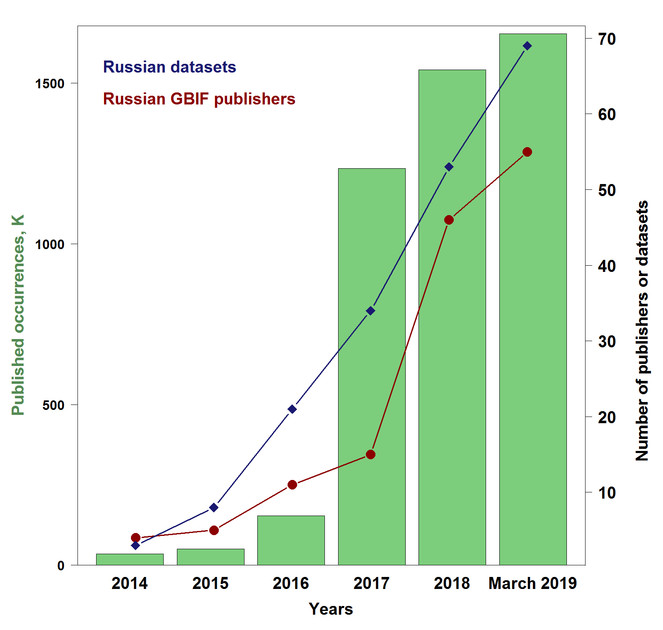|
Biodiversity Information Science and Standards : Conference Abstract
|
|
Corresponding author: Maxim Shashkov (max.carabus@gmail.com)
Received: 09 Jun 2019 | Published: 18 Jun 2019
© 2019 Maxim Shashkov, Natalya Ivanova
This is an open access article distributed under the terms of the Creative Commons Attribution License (CC BY 4.0), which permits unrestricted use, distribution, and reproduction in any medium, provided the original author and source are credited.
Citation: Shashkov M, Ivanova N (2019) Considerable Progress in Russian GBIF Community. Biodiversity Information Science and Standards 3: e37015. https://doi.org/10.3897/biss.3.37015
|
|
Abstract
Russia is a huge gap on the open access global biodiversity map of the Global Biodiversity Information Facility (GBIF). National biodiversity data are stored in various sources including museums, herbaria, scientific literature and reports as well as in the private collections and local databases. The best known and largest of the Russian herbarium collections are the collections stored in Komarov Botanical Institute of the Russian Academy of Science (>6 M sheets) and Moscow University (>1 M sheets). The largest zoological collection is located in Zoological institute of the Russian Academy of Science, with >60 M specimens. But most of the national biodiversity data is not yet digitized. The national biodiversity portal as well as the list of Russian biodiversity data sources are still absent. Despite this, projects and other activities are implemented to mobilize a national data using international biodiversity data standards.
Currently Russia is not a GBIF member, but in the last 5 years, more than 1.6 M occurrences were published by Russian publishers through GBIF.org (69 datasets at the end of March 2019). The largest GBIF data provider in Russia is the Lomonosov Moscow State University. The Digital Moscow University Herbarium includes 971,732 specimens collected from Russia and many other countries. The Russian GBIF community is steadily expanding (Fig.
Russian-language biodiversity informatics materials are collected and presented from an informal web site http://gbif.ru/ with three main sections:
- data publishing through GBIF,
- Russian GBIF activities, and
- Russian biodiversity data sources.
Additional sections are dedicated to iNaturalist citizen science system and Russian Specify Software Project community. We provide technical helpdesk support not only for Russian publishers, but also for Russian speakers from the former USSR. The national mailing-list (via google groups) aims to provide a platform for news sharing. Now it includes >240 subscribers.
Since the end of 2014, regular biodiversity informatics events are being held in Russia. Last year, two data training courses, funded by GBIF (project ID Russia-02 - "GBIF.ru data mobilization activities") and ForBIO (Research school in biosystematics), were organized in Moscow and Irkutsk region with the participation of 29 Russian researchers. National biodiversity informatics conferences were held in Apatity (2017) and Irkutsk (2018).
We believe Russia already has a well established community that can become the basis for further development when Russia becomes a GBIF member.
Keywords
Russia, data mobilization, GBIF
Presenting author
Maxim Shashkov
Presented at
Biodiversity_Next 2019
